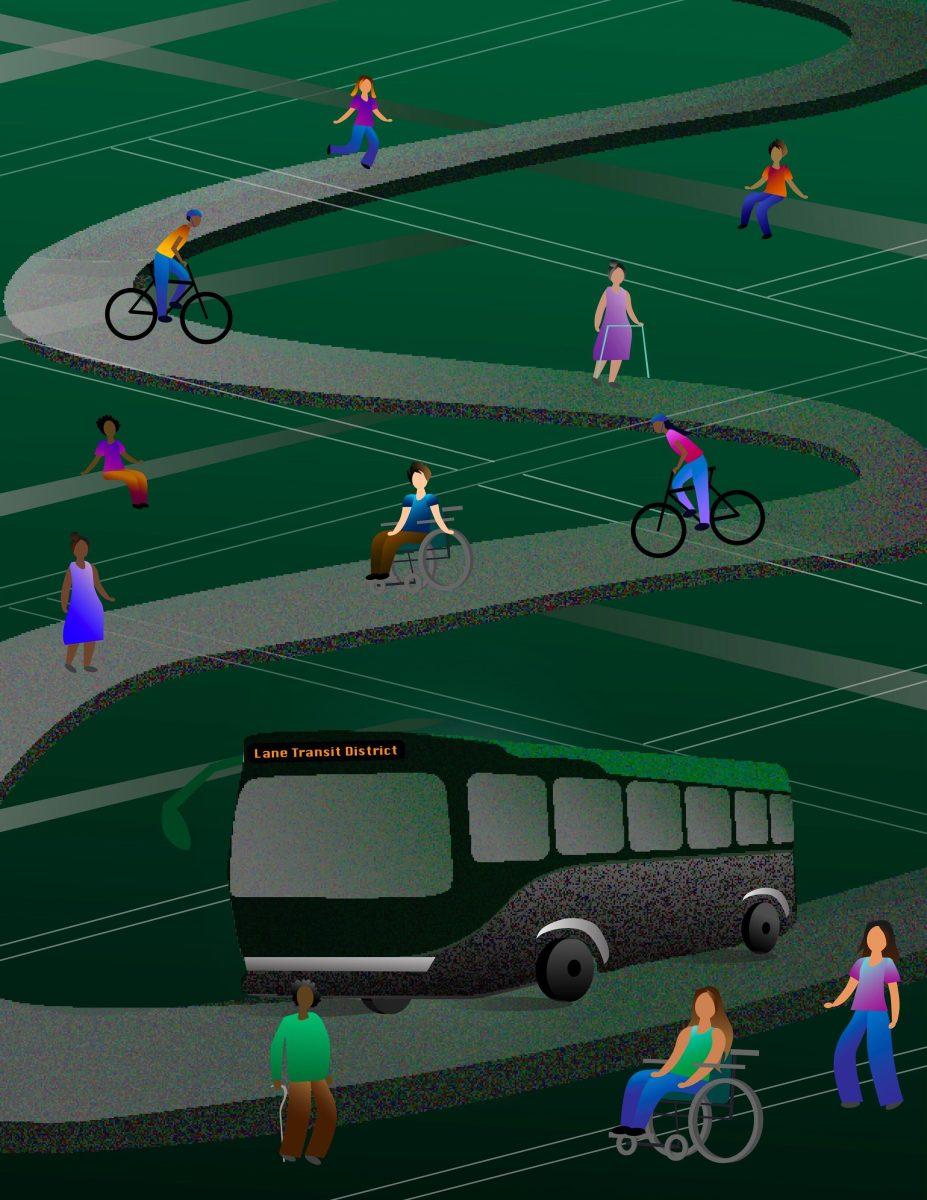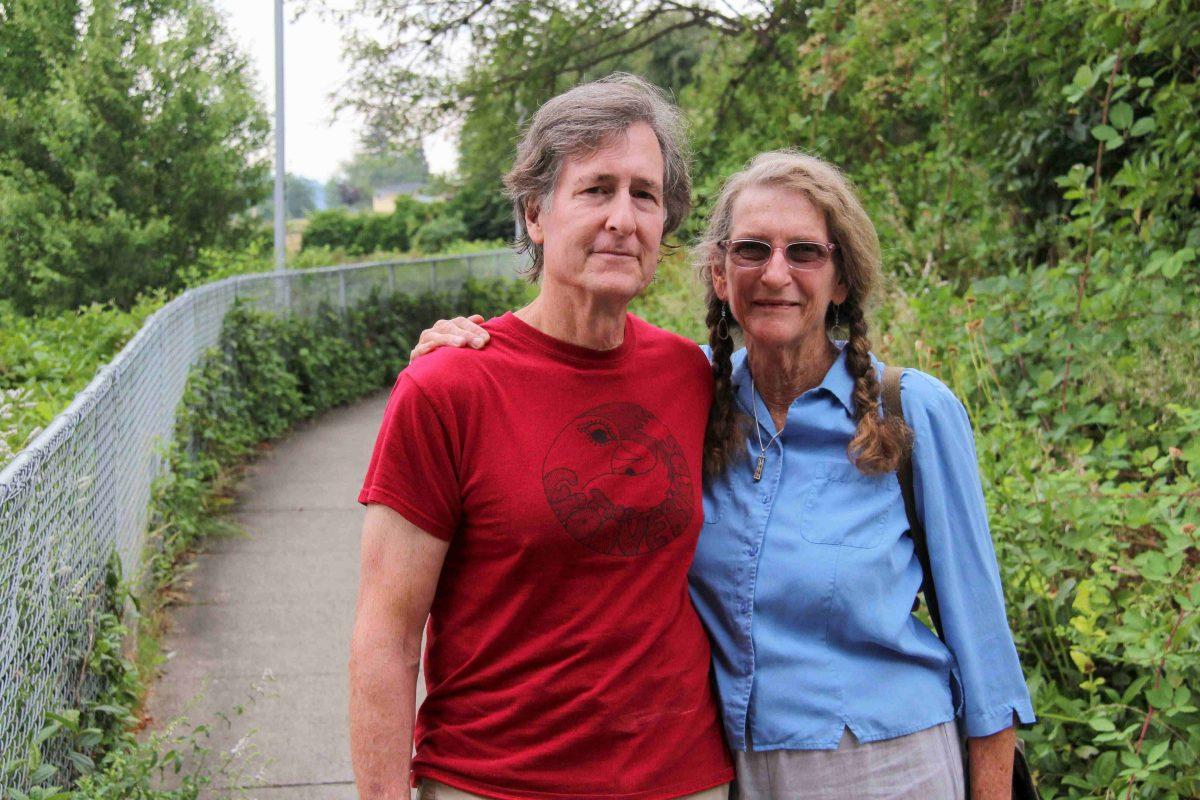The Eugene Station’s burgundy arches are instantly recognizable. A passage for buses covers nearly the entire block, a feature unlike the surrounding downtown shop buildings.
Around noon, several buses station themselves to their respective bays and a loud alarm alerts other passengers that a ramp is declining so a wheelchair rider can safely exit the bus. A passenger with a service dog walks out of the secondary exit door. As everyone else exits and enters the bus, the platform measures the number of passengers at the station.
Two women, Kathy Jenness and Karen, carefully exit the Route 82 bus and travel across the bay to look at the Route 66 and 67 schedules. Karen looks closely at the bus schedule while Jenness drives her electric wheelchair near her to explain something.
“Kathy is kindly instructing me on how to use the bus system here,” Karen says.
As a Lane Transit District (LTD) transit host, Jenness specializes in the assistance of people with disabilities and seniors. She also has been an avid user of LTD since converting to a wheelchair in 1994. Karen is a retired senior and has met Jenness several times a week this summer to help familiarize her with the bus system through LTD’s Travel Training Program. This program trains riders to gain confidence in their abilities to use bus transit around Eugene and Springfield with the assistance of qualified volunteers.
Data USA reports that the average car ownership in Eugene is approximately two vehicles per household. Many American cities, including Eugene, plan transportation in a way that prioritizes cars as the fastest and primary mode of transportation, as shown through car lanes and highways.
However, not everyone can use this type of private transportation, and LTD offers alternative public transportation services to benefit demographics that depend on public transportation. According to Pat Walsh, the LTD marketing and communications director, 18,000 people have used LTD’s bus services since the onset of COVID-19. That’s only about 11% of Eugene’s population, according to the 2020 U.S. Census Bureau.
With a car, those with mobility issues often need the assistance of others to seat them in the vehicle before traveling. Public transportation, including LTD, allows disabled individuals to have more control and independence in their day, according to Joe Basey – who works as an adaptive recreation instructor for the city of Eugene to plan events for people with disabilities.
“It makes you feel better. It makes you feel more confident in your own ability to be able to do more stuff on your own,” Basey says. “When people are stuck at home, it’s hard for them to stay home all the time. A lot of people don’t like staying home and rather go out in the community. It’s also better for your mental health. It’s that simple, you know?”
In addition to the Travel Training Program, LTD offers other accessible features that encourage riders to gain confidence in their independent commute. Ramps allow riders to enter the bus without others’ assistance.
LTD also offers RideSource, an ADA community transport vehicle that services directly to desired locations for those who cannot use a fixed-route bus service due to a disability, as it is required by the Americans with Disabilities Act. Additionally, it offers a free transit pass for K-12 students as well as eligible students and employees at the University of Oregon, Lane Community College and Pacific University.
For the time that Jenness has worked at LTD as a transit host, she also benefits from its accessible initiatives for seniors like her. She says that the bus is “such an asset to my life. It’s personalized: people are very kind, very generous in their time and their energy in helping them, whatever people need.”
Though its services towards seniors and disabled riders have accessible aspects, other riders desire further improvements. Several online forums complain that there aren’t frequent enough stops or that the intersectionality between routes is inefficient, and Basey agrees.
He often rides Route 73 to go downtown or Route 28 to go to work, both coming every thirty minutes. That means that if a person misses a 10:30 a.m. bus, they have to wait until 11:00 a.m. Before the COVID-19 pandemic caused more people to stay home, Basey says the buses used to come more often because there were more riders.
“For an average person, they just have to get up, get in the car and go out,” Basey says. In addition to his advocacy for people with disabilities, Basey also has cerebral palsy (CP), a motor disability that affects maintaining balance and posture. “But for people with disabilities, they have to get up and navigate the timing, navigate how long it takes to go to the bus stop and how long it takes to get on the bus. So we have more details and more stuff to travel with.”
LTD changes its service hours depending on the season. While some routes like Route 79x (UO/Kinsrow) do not operate while UO is not in session, Route 18, which services Mohawk and Springfield, and Route 40, which services Whiteaker and Bethel neighborhoods, made additional time slots during the weekdays to accommodate increased ridership demand.
Unfortunately, even if frequent transit on every route was possible, it’s not an effective use of resources, nor is it possible with the current city patterns, according to Marc Schlossberg, a professor of Planning, Public Policy and Management at UO. He says the land use of the city directly affects public transportation’s ability to perform its goals, whether those goals prioritize productivity or coverage.
Schlossberg says that in many American cities before the 1950s, residential areas and commercial activities, like shopping, were in the same vicinity, and often only required walking to go between the two. Since both services were in the same area, it generated a high-density city in which many people were located in the same area. This allowed streetcars to service many riders throughout the day.
However, the post-1950s era came with the increased prevalence of cars, which resulted in a phenomenon called urban sprawl. Urban sprawl separated commercial and residential areas in cities to benefit the marketing of automobiles. Highways and large parking lots were required to accommodate car commuters.
As homes transitioned from mixed-use buildings that simultaneously had homes and shops to single-family structures, people started to live farther apart from each other. While a car allowed faster commuting from their homes, elements that prioritized it resulted in low-density regions.
Schlossberg says that it’s difficult to always strive for productivity in public transportation when population density varies depending on each area of the city.
“If we are to think of a good transit system as one where people are actively using it, you need to have density,” he says. “Because to get on or off a bus, you’re a pedestrian, and there’s a limit to how far you can move. So successful transit, in terms of ridership, needs density of buildings, density of where people live, density of where people are going.”
To adapt to the city’s varying density, LTD’s current system includes six route types based on desired goals within land boundaries that are defined as high, middle and low density. Walsh says that because LTD desires to serve as many people as possible, not every route prioritizes high productivity.
For example, EmX’s Bus Rapid Transit is a route type that includes bus-only corridors to accommodate high ridership and frequent service, because it is near multiple activities downtown. Another route type called Community Routes such as Route 33 (Jefferson) are suburban neighborhoods that do not have high urban development compared to downtown, and the abundance of car ownership means there are fewer passengers. Community Routes don’t require frequent service, allowing route planners to allocate more buses on routes that have more ridership.
Walsh also points out that neither the routes nor times are indefinitely fixed, and LTD revises them after measuring the number of passengers detected through the infrared sensors on the bus.
“Three times a year, LTD reviews its routes and then makes changes based on ridership that we can measure,” Walsh says. “When you step onto the bus, we know somebody stepped on it. So that’s the data we’re going to look at, and we also need to look at employment trends.” He says that if more people are doing remote work, bus service may not be necessary for specific areas.
As frustrating as some riders find it, Walsh says that Lane Transit District is a system carefully calculated by employees analyzing ridership demand, and strives to serve people who are dependent on public transportation in a sprawling city.
Additionally, Walsh says LTD plans to do a random community values survey and a more targeted survey to specific communities to ensure LTD is adequately serving those that rely on public transportation.
To further respond to community input, LTD is working on a project called MovingAhead. The goal of this project is to connect homes and commercial activities with frequent service by proposing transportation investments on five key corridors. Walsh says that this project will further engage the public for feedback and will seek funding from the federal government to make further improvements on the next iteration of the corridors.
Even though it may take years for the proposal to be approved, Walsh says it’s the perfect opportunity to consider additional revisions when ridership and employment patterns have decreased since COVID. Even though its infrequent service in low-density locations is not accessible to everyone, several of LTD’s 18,000 riders enjoy the service it offers, especially those who depend on public transportation.
Belea Onorato, a high school student, has lived in Eugene for three years and says she has found her LTD commute convenient. She takes the Route 40 bus on Mondays, Wednesdays and Fridays to go to her volunteer jobs after her summer class, and sometimes another route to check in with her supervisor.
“I like how the systems connect to each other and pass by important locations,” Onorato says. “Even though it takes a while to get to where I need to go, I still get there on time.”
Jenness also looks on the bright side, and says that riders can use their time on the bus as an opportunity to slow down and enjoy the ride.
“You can read a book, you can listen to something with your earphones, take a snooze or, you know, visit with friends on the bus,” Jenness says.







![[Photo Courtesy of the Lara Family]
Ruben embraces his beloved childhood goat, Katrina.](https://ethos.dailyemerald.com/wp-content/uploads/2025/05/katrina-1-1060x1200.jpg)


